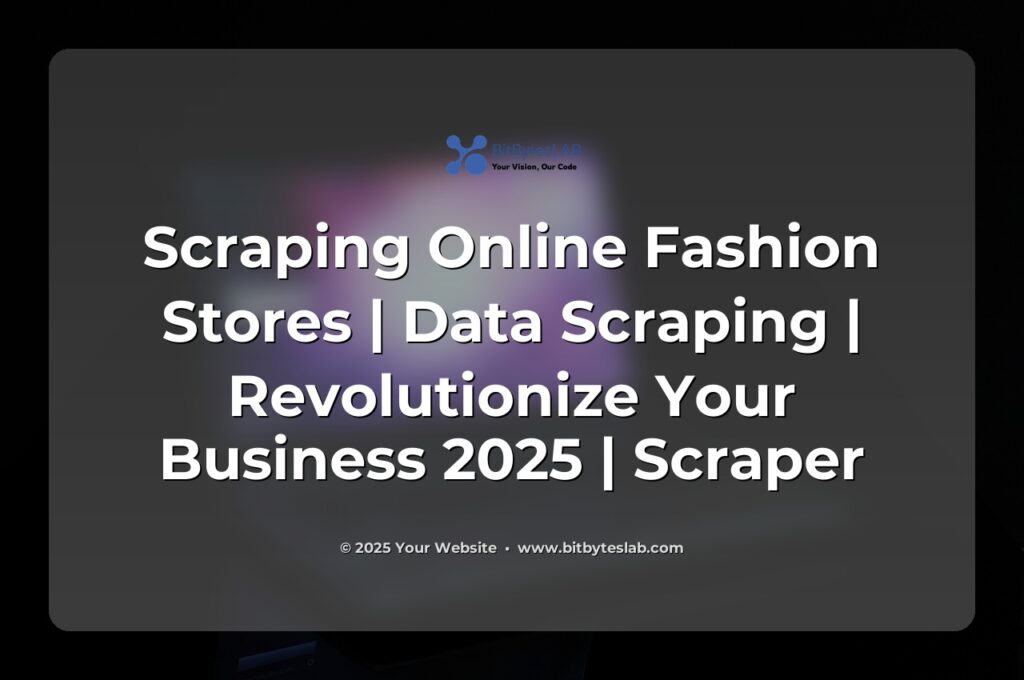Ever feel like you’re chasing the next big trend in fashion only to discover it’s already been priced, reviewed, and stocked by a dozen competitors? In 2025, the race to stay ahead is no longer about who designs the next runway‑ready look—it’s about who can extract actionable data at lightning speed. If you’re a retailer, brand, or analytics firm, mastering online fashion store scraping is your secret weapon to unlock real‑time pricing, inventory, and consumer sentiment.
Identifying the Problem
Retailers routinely face three pain points: price volatility, inventory uncertainty, and the knowledge gap that comes from siloed data. A single store’s price change can ripple through the market, and an unnoticed out‑of‑stock item can cost you a sale or brand loyalty. Traditional data feeds or manual scraping are too slow, error‑prone, and costly. The question is not if you need data scraping—it’s how to do it effectively.
Core Concepts & Methodologies
At the heart of any fashion scraping initiative lie a few foundational pillars: target data, content type, API versus UI extraction, proxy strategy, and data normalization. Think of target data as the recipe for your analytics: product name, SKU, price, size variants, images, and reviews. Meanwhile, static vs. dynamic content tells you whether you need a headless browser or a simple HTTP client. API‑first gives you clean, well‑documented endpoints, but when those are absent, UI‑scraping becomes the fallback.
Equally vital is a rotation of IPs and User‑Agent strings to sidestep rate limits and CAPTCHAs. Every request should feel like a genuine shopper: a realistic viewport, a handful of mouse movements, and a random delay before the next click. Finally, data normalization—standardizing prices to a base currency, converting size charts, and mapping brand tags—ensures that downstream models ingest clean, comparable data.
⚡ A SQL query goes into a bar, walks up to two tables and asks… ‘Can I join you?’ 🍺

Expert Strategies & Approaches
Start with a lightweight crawler to map the site’s architecture: category URLs, pagination patterns, and product identifiers. Once you have a URL map, layer in a headless browser only for the pages that render essential data via JavaScript—most modern retailers use React or Vue for their product grids. Leverage network interception to capture underlying API calls; often the site’s own JSON payloads contain the same data you’d otherwise parse from the DOM, saving time and reducing anti‑scraping friction.
When it comes to scaling, a containerized environment (Docker or Kubernetes) paired with a resilient proxy pool—preferably residential—enables you to run thousands of threads without triggering blacklists. Coupled with a robust back‑off algorithm that respects Retry‑After headers, you’ll maintain high uptime while staying within the target’s acceptable request window.
Throughout, keep the data pipeline idempotent. Store raw HTML alongside extracted JSON for auditability, and enforce deduplication on SKU‑size pairs. Implement structured logging and a real‑time dashboard (Grafana, Prometheus) to monitor latency spikes, 429 errors, and proxy health. A quick visual cue can save hours of debugging when a site redesign breaks selectors.
Industry Insights & Market Impact
According to a 2024 market study, retailers who integrate real‑time pricing data see a 12% lift in conversion rates and a 7% reduction in markdowns. Moreover, trend forecasting teams that ingest 10‑plus brand feeds outpace competitors by 2–3 months in product launches. In the luxury segment, 45% of consumers now compare sizing charts across sites before checkout—accurate, standardized size data can reduce returns by up to 25% (source: Pacific Retail Study).
These numbers underscore a simple truth: data is not a luxury; it’s a competitive moat. Whether you’re a startup building a price‑comparison app or a legacy brand revamping its omni‑channel strategy, a well‑architected scraping system feeds the models that predict demand, price elasticity, and customer churn.
💻 How many programmers does it take to change a light bulb? None, that’s a hardware problem! 💡

Business Applications & ROI
Here are three real‑world use cases that translate scraped data into tangible ROI:
- Dynamic Pricing Engines: Instantly adjust your online rates based on competitor windows, seeding a 5–8% uplift in gross margin.
- Inventory Forecasting: Feed SKU‑size availability into demand models, cutting stockouts by 30% and reducing excess inventory costs.
- Personalized Marketing: Combine review sentiment, brand affinity, and price history to send hyper‑targeted email campaigns—average open rates surge from 22% to 35%.
When you factor in the cost savings from reduced markdowns, lower returns, and higher customer lifetime value, the breakeven point for a scraping stack often falls under six months.
Common Challenges & Expert Solutions
Even seasoned practitioners wrestle with five recurring obstacles:
- JavaScript‑Heavy Sites: Use headless browsers with network interception; fallback to JSON‑LD when available.
- CAPTCHAs & Rate Limits: Rotate residential proxies, introduce human‑like idle times, and employ stealth user‑agents.
- Site Breakages: Implement automated visual regression tests and keep a versioned selector repository.
- Legal & Ethical Concerns: Respect robots.txt, terms of service, and privacy laws; avoid personal data where possible.
- Data Volume: Store raw dumps in object storage (S3) and process with columnar formats (Parquet) to keep queries fast.
Future Trends & Opportunities
Looking ahead, 2025 will see AI‑driven selector generators that reduce the need for manual CSS paths, and GraphQL APIs emerging from large retailers to expose curated product feeds. Serverless architectures will allow instant scaling for flash sales, while real‑time streaming with Kafka or Kinesis will transform scraped events into live dashboards. And, with privacy regulations tightening, data‑clean‑room approaches will become essential for cross‑brand collaboration.
Staying on top of these developments means you keep the same agile mindset that drove the first wave of e‑commerce: iterate fast, test relentlessly, and always look to the data for the next competitive advantage.
Ready to boost your fashion intelligence? BitBytesLab specializes in streamlined, compliant web scraping and data extraction solutions that keep you ahead of the trend curve. Let us handle the heavy lifting while you focus on style, strategy, and sales.

